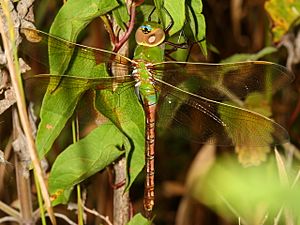Green darner facts for kids
Quick facts for kids Green darner |
|
|---|---|
 |
|
| Adult female, Blackwell Forest Preserve, Illinois | |
| Conservation status | |
| Scientific classification | |
| Synonyms | |
|
The green darner (Anax junius) is a large, colorful dragonfly. It gets its name because its body looks a bit like a darning needle. This amazing insect is one of the most common dragonflies in North America. You can find it from the northern United States all the way south to Panama.
Green darners are famous for their long migrations. They fly huge distances from the northern U.S. down to Texas and Mexico. They also live in the Caribbean, Tahiti, and parts of Asia, like Japan and China. The green darner is even the official insect for the state of Washington in the United States!
These dragonflies are quite big. Males can grow up to 76 mm (3 inches) long. Their wingspan can reach up to 80 mm (3.1 inches).
Female green darners lay their eggs in water plants. The eggs are placed under the water's surface. Baby green darners, called nymphs, live in the water. They are fierce hunters! Nymphs eat other insects, tadpoles, and even small fish. Adult green darners catch insects while flying. They eat ants, moths, mosquitoes, and flies.
Contents
What is a Green Darner?
The green darner is a type of dragonfly. It belongs to a family called Aeshnidae. In 1773, a scientist named Dru Drury first described this species. He named it Libellula junius. Today, we know it as Anax junius.
Where Green Darners Live
You can find common green darners all over the United States and southern Canada. Sometimes, they fly as far south as Panama, especially in winter. There are also groups of them living in Hawaii and the Caribbean.
Sometimes, a green darner might be seen far from its usual home. They have been spotted in places like Alaska, Russia, China, Japan, France, and the United Kingdom. These are likely migrating dragonflies. Strong winds or storms might blow them off course.
Green Darner Features
Green darners are large dragonflies. They are usually between 6.8 to 8 cm (2.7 to 3.1 inches) long. Their wings can spread up to 10 cm (3.9 inches) wide.
Both male and female green darners have a bright green body section called the thorax. This part is always green and has no other marks.
Mature male green darners have beautiful bluish-purple abdomens. The front parts of their abdomens are the brightest blue. They also have a black stripe along their back. This stripe gets wider near the end of the abdomen.
Younger males and most females have reddish-brown abdomens. But some females can look like adult males with blue abdomens.
Their wings start out clear. As they get older, their wings often turn a bit amber, especially in females.
Both male and female green darners have a black "bulls-eye" mark on their face. This mark is right in front of their eyes. It helps tell them apart from other similar dragonflies. For example, the comet darner looks similar but doesn't have this mark.
Green darners have a special way of laying eggs. The male and female fly together in a unique position. This is called tandem oviposition. It's a rare behavior among North American darners.
Green Darner Life
What Green Darners Eat
Both young (nymphs) and adult green darners are predators. This means they hunt and eat other creatures.
Green darner nymphs live in the water. They hunt small aquatic insects, tiny crustaceans, and even small tadpoles. Sometimes, they even eat very small fish.
Adult green darners mostly eat flying insects. They catch wasps, flies, butterflies, and even other dragonflies.
Who Eats Green Darners
Fish are the main predators of green darner nymphs. Adult green darners can be eaten by birds. Sometimes, they are also caught by robber flies, spiders, or other large dragonflies.
Where Green Darners Live
Green darner nymphs grow up in lakes, ponds, and slow-moving streams or rivers. Adult green darners are often seen near these watery places. However, they are very strong fliers. This means you can find them in many different places. They might be in grasslands, forests, or even in cities.
Amazing Migration
Many types of dragonflies migrate in North America. But green darners are the ones we know the most about. Other migrating dragonflies include:
- Black saddlebags (Tramea lacerata)
- Wandering glider (Pantala flavescens)
- Spot-winged glider (Pantala hymenea)
- Variegated meadowhawk (Sympetrum corruptum)
Green darners live in a very large area. Their migration habits are complex. Scientists have learned that there are likely at least three different groups of green darners each year.
The first group hatches in the southern parts of their range. They emerge in early spring and fly north. This journey continues through spring and summer.
The second group hatches in the northern parts of their range in summer. They then fly south in the fall.
The third group stays in the south during the winter. These dragonflies do not migrate.
Green darners migrate in both fall and spring. However, their southward journey in the fall is usually easier to spot.
Scientists have attached tiny radio transmitters to green darners. They found that these dragonflies can fly up to 140 km (87 miles) in a single day! But they usually fly shorter distances each day.
One study looked at green darners caught between Ontario and Mexico in the fall. They found that over 90% of these dragonflies were moving south. On average, they flew about 900 kilometers (560 miles).
Another study in 2019 used tiny radio transmitters. They tracked green darners near the Great Lakes. These dragonflies flew at an average speed of 16 km/h (10 mph).
Gallery
-
Hovering San Joaquin Wildlife Sanctuary







